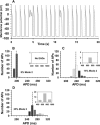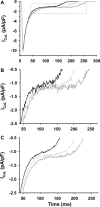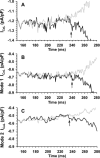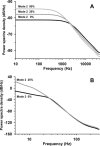The role of stochastic and modal gating of cardiac L-type Ca2+ channels on early after-depolarizations
- PMID: 15501946
- PMCID: PMC1201453
- DOI: 10.1529/biophysj.104.051508
The role of stochastic and modal gating of cardiac L-type Ca2+ channels on early after-depolarizations
Abstract
Certain signaling events that promote L-type Ca2+ channel (LCC) phosphorylation, such as beta-adrenergic stimulation or an increased expression of Ca(2+)/calmodulin-dependent protein kinase II, promote mode 2 gating of LCCs. Experimental data suggest the hypothesis that these events increase the likelihood of early after-depolarizations (EADs). We test this hypothesis using an ionic model of the canine ventricular myocyte incorporating stochastic gating of LCCs and ryanodine-sensitive calcium release channels. The model is extended to describe myocyte responses to the beta-adrenergic agonist isoproterenol. Results demonstrate that in the presence of isoproterenol the random opening of a small number of LCCs gating in mode 2 during the plateau phase of the action potential (AP) can trigger EADs. EADs occur randomly, where the likelihood of these events increases as a function of the fraction of LCCs gating in mode 2. Fluctuations of the L-type Ca2+ current during the AP plateau lead to variability in AP duration. Consequently, prolonged APs are occasionally observed and exhibit an increased likelihood of EAD formation. These results suggest a novel stochastic mechanism, whereby phosphorylation-induced changes in LCC gating properties contribute to EAD generation.
Figures







Similar articles
-
Mechanistic Investigation of the Arrhythmogenic Role of Oxidized CaMKII in the Heart.Biophys J. 2015 Aug 18;109(4):838-49. doi: 10.1016/j.bpj.2015.06.064. Biophys J. 2015. PMID: 26287635 Free PMC article.
-
Mechanisms of excitation-contraction coupling in an integrative model of the cardiac ventricular myocyte.Biophys J. 2006 Jan 1;90(1):77-91. doi: 10.1529/biophysj.105.065169. Epub 2005 Oct 7. Biophys J. 2006. PMID: 16214852 Free PMC article.
-
CaMKII-induced shift in modal gating explains L-type Ca(2+) current facilitation: a modeling study.Biophys J. 2009 Mar 4;96(5):1770-85. doi: 10.1016/j.bpj.2008.11.055. Biophys J. 2009. PMID: 19254537 Free PMC article.
-
Computational biology in the study of cardiac ion channels and cell electrophysiology.Q Rev Biophys. 2006 Feb;39(1):57-116. doi: 10.1017/S0033583506004227. Epub 2006 Jul 19. Q Rev Biophys. 2006. PMID: 16848931 Free PMC article. Review.
-
Calmodulin kinase and L-type calcium channels; a recipe for arrhythmias?Trends Cardiovasc Med. 2004 May;14(4):152-61. doi: 10.1016/j.tcm.2004.02.005. Trends Cardiovasc Med. 2004. PMID: 15177266 Review.
Cited by
-
Nonlinear dynamics in cardiology.Annu Rev Biomed Eng. 2012;14:179-203. doi: 10.1146/annurev-bioeng-071811-150106. Epub 2012 Apr 18. Annu Rev Biomed Eng. 2012. PMID: 22524390 Free PMC article. Review.
-
Estimating the probability of early afterdepolarizations and predicting arrhythmic risk associated with long QT syndrome type 1 mutations.Biophys J. 2023 Oct 17;122(20):4042-4056. doi: 10.1016/j.bpj.2023.09.001. Epub 2023 Sep 12. Biophys J. 2023. PMID: 37705243 Free PMC article.
-
Mechanistic Investigation of the Arrhythmogenic Role of Oxidized CaMKII in the Heart.Biophys J. 2015 Aug 18;109(4):838-49. doi: 10.1016/j.bpj.2015.06.064. Biophys J. 2015. PMID: 26287635 Free PMC article.
-
Voltage noise influences action potential duration in cardiac myocytes.Math Biosci. 2007 Jul;208(1):125-46. doi: 10.1016/j.mbs.2006.09.023. Epub 2006 Oct 25. Math Biosci. 2007. PMID: 17174348 Free PMC article.
-
Phospholemman is a negative feed-forward regulator of Ca2+ in β-adrenergic signaling, accelerating β-adrenergic inotropy.J Mol Cell Cardiol. 2012 May;52(5):1048-55. doi: 10.1016/j.yjmcc.2011.12.015. Epub 2012 Jan 20. J Mol Cell Cardiol. 2012. PMID: 22289214 Free PMC article.
References
-
- Anderson, M. E. 2004. Calmodulin kinase and L-type calcium channels: a recipe for arrythmias? Trends Cardiovasc. Med. 14:152–161. - PubMed
-
- Chen, X., V. Piacentino III, S. Furukawa, B. Goldman, K. B. Margulies, and S. R. Houser. 2002. L-type Ca2+ channel density and regulation are altered in failing human ventricular myocytes and recover after support with mechanical assist devices. Circ. Res. 91:517–524. - PubMed
-
- De Ferrari, G. M., M. C. Viola, E. D'Amato, R. Antolini, and S. Forti. 1995. Distinct patterns of calcium transients during early and delayed afterdepolarizations induced by isoproterenol in ventricular myocytes. Circulation. 91:2510–2515. - PubMed
Publication types
MeSH terms
Substances
Grants and funding
LinkOut - more resources
Full Text Sources
Other Literature Sources
Miscellaneous

